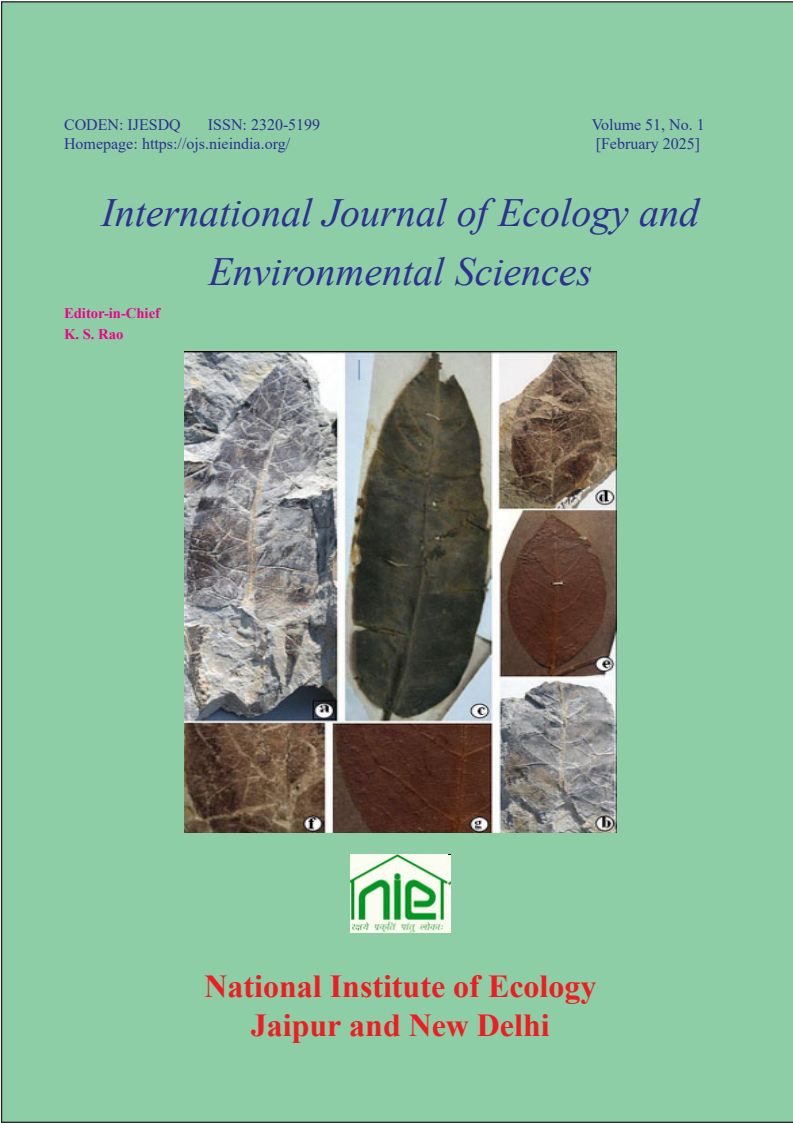Assessment of Forest Fragmentation of Rajaji National Park, Uttarakhand
DOI:
https://doi.org/10.55863/ijees.2024.0369Keywords:
Forest, Fragmentation, Invasive, Scrub, Geospatial toolsAbstract
The geospatial landscape characterization of Rajaji National Park (RNP), Uttarakhand, exhibited Forest as the largest patch among the four land-use classes of Forest, Scrub, Water channels, and Non-Forest. The Land Use Land Cover (LULC) changes for 10 years from 1995 to 2005 depicted a decrease in forested area by 17% and water area by 20%. On the other hand, non-forest areas increased by 35% and scrub area increased by 172%. However, in the next 10 years, from 2005 to 2015, new management practices in the park resulted in an increase in the forest by 2% and water areas by 32%, respectively; there was a decrease in the non-forest area by 38%. However, the scrub area had increased again by another 15%. Overall, in 20 years, from 1995 to 2015, there was 212% increase in area under scrub and 15% decrease in area under forest. The steady increase in area under scrub resulted in greater patchiness of the RNP landscape that impacted qualitative indices such as Shannon’s diversity index, contiguity, connect and fractal dimensions of the Park landscape from 1995 to 2015. The invasive character of the scrub was primarily due to the presence of the invasive species Lantana camara, which was one of the driving forces that fragmented the forests of RNP. The scrub not only increased in number and size but also exhibited multi-directional dispersion. The invasive attribute of the scrub exhibited a tendency to coalesce its random patches and engulf the forested areas. The regular monitoring, assessment and remodelling of the scrub would be critical in combating the forest fragmentation of RNP. Hence, this study brings forth the use of geospatial tools as an effective medium for studying the quantitative and qualitative changes in land use patterns of large protected areas. Such studies are important to ensure the ecosystem services of a National Park for in-situ biodiversity conservation.
References
Adhikari, K.R., Tan, Y-C., Lai, J-S. and Pant, D. 2009. Irrigation intervention: a strategy for conserving biodiversity and improving food security in Royal Chitwan National Park buffer zone, Nepal. Irrigation & Drainage, 58(5), 522-537. https://doi.org/10.1002/ird.443
Carleton, T.A. and Hsiang, S.M. 2016. Social and economic impacts of climate. Science, 353 (6304), 1112 (15 pages). https://doi.org/10.1126/science.aad9837
Geist, H.J. and Lambin, E.F. 2002. Proximate Causes and Underlying Driving Forces of Tropical Deforestation. BioScience, 52, 143-150. https://doi.org/10.1641/0006-3568(2002)052[0143:PCAUDF]2.0.CO;2
Imre, A.R. and Bogaert, J. 2004 The Fractal Dimension as a Measure of the Quality of Habitats. Acta Biotheoretica, 52, 41-56. http://dx.doi.org/10.1023/B:ACBI.0000015911. 56850.0f
Jaquet, S., Schwilch, G., Hartung-Hofmann, F., Adhikari, A., Sudmeier-Rieux, K., Shrestha, G., Liniger, H.P. and Kohler, T. 2015. Does outmigration lead to land degradation? Labour shortage and land management in a western Nepal watershed. Applied Geography, 62, 157-170. https://doi.org/10.1016/j.apgeog.2015.04.013
Johnsingh, A.J.T., Prasad, S.N. and Goyal, S.P. 2015. Conservation status of the Chilla–Motichur corridor for elephant movement in Rajaji–Corbett national parks area, India. Biological Conservation, 51(2), 125-138. https://doi.org/10.1016/0006-3207(90)90107-Z
Joshi, A., De Smet, R., Marchal, K., van de Peer, Y. and Michoel, T. 2009. Module networks revisited: computational assessment and prioritization of model predictions. Bioinformatics, 25(4), 490-496. https://doi.org/10.1093/bioinformatics/btn658
Joshi, P.K., Yadav, K. and Sinha, V.S.P. 2011. Assessing impact of forest landscape dynamics on migratory corridors: a case study of two protected areas in Himalayan foothills. Biodiversity and Conservation, 20, 3393-3411. https://doi.org/10.1007/s10531-011-0123-z
Kumar, M., Padalia, H., Nandy, S., Singh, H., Khaiter, P. and Kalra, N. 2019. Does spatial heterogeneity of landscape explain the process of plant invasion? A case study of Hyptis suaveolens from Indian Western Himalaya. Environmental Monitoring and Assessment, 191(3), 794. https://doi.org/10.1007/s10661-019-7682-y
Mishra, A.K. and Singh, V.P. 2011. Drought modeling-A review. Journal of Hydrology, 403(1-2), 157-175. https://doi.org/10.1016/j.jhydrol.2011.03.049
Mungi, N.A., Qureshi, Q. and Jhala, Y.V. 2020. Expanding niche and degrading forests: Key to the successful global invasion of Lantana camara (sensu lato). Global Ecology and Conservation, 23, e01080. https://doi.org/10.1016/j.gecco.2020.e01080
Neena, P. and Joshi, P.K. 2007. A review of Lantana camara studies in India. International Journal of Scientific and Research Publications, 3(10), 1-11. https://www.ijsrp.org/research-paper-1013/ijsrp-p2207.pdf
Peptenatu, D., Andronache, I., Ahammer, H., Radulovic, M., Costanza, J.K., Jelinek, H.F., Di leva, A., Koyama, K., Grecu, A., Gruia, A.K., Simion, A-G., Nedelcu, L.D., Olteanu, C., Draghici, C-C., Marin, M., Diaconu, D.C., Fensholt, R. and Newman, E.A. 2023. A new fractal index to classify forest fragmentation and disorder. Landscape Ecology, 38, 1373-1393. https://doi.org/10.1007/s10980-023-01640-y.
Rindfuss, R.R., Walsh, S.J., Turner, B.L., Fox, J. and Mishra, V. 2004. Developing a science of land change: challenges and methodological issues. Proceedings of the National Academy of Sciences, USA, 101(39), 13976-13881. https://doi.org/10.1073/pnas.0401545101
Sun, J., Huang, J., Zhen, Q., Southworth, J. and Perz, S. 2014. Fractally deforested landscape: Pattern and process in a tri-national. Applied Geography, 52, 204-211. https://doi.org/10.1016/j.apgeog.2014.05.01
Downloads
Published
How to Cite
Issue
Section
License
Copyright (c) 2024 Biswarupa Ghosh, Debabarata Saha

This work is licensed under a Creative Commons Attribution-NonCommercial 4.0 International License.


